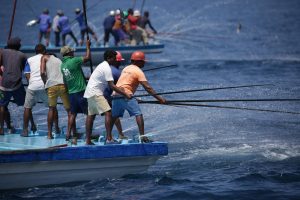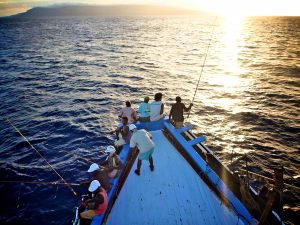IPNLF reached out to Whale and Dolphin Conservation (WDC), one of the world’s leading charities working to conserve and protect marine mammals, to discuss the issue of bycatch in tuna fisheries.
Here at the International Pole & Line Foundation, we whole-heartedly support coastal communities that rely on one-by-one tuna fisheries. Indeed, many of these fisheries are located in nations regarded as “least economically developed” providing critically important food and work opportunities. However, we also believe there are environmental benefits to this fishing method, including a reduced risk of injury to marine mammals. As such, we reached out to Whale and Dolphin Conservation (WDC), one of the world’s leading charities working to conserve and protect these marine mammals, to discuss the issue of bycatch in tuna fisheries.
Guest Blog by Sarah Dolman, Senior Policy Manager, WDC
According to a recently published report, tuna ranks as one of the world’s most economically valuable fish, with consumers spending more than $40 BILLION USD annually. However, an increasingly savvy public is also looking to purchase fish that are caught sustainably. When buying canned tuna, it’s important to have access to sufficient information to be able to make an informed choice and there are issues in addition to the sustainability of tuna populations to consider.
The majority of tuna is caught by large commercial fishing vessels, some of which use miles of baited hooks and some which deploy walls of netting around schools of fish. Unfortunately, both methods – and the associated use of devices to attract these fish – often result in the unintentional killing of thousands of marine species, including dolphins, whales, turtles, sharks and seabirds.
these fish – often result in the unintentional killing of thousands of marine species, including dolphins, whales, turtles, sharks and seabirds.
In the US Eastern Tropical Pacific (ETP), some purse seine fishermen use speed boats to intentionally chase, herd and surround dolphins while releasing walls of encircling nets to capture yellowfin tuna found swimming nearby. As a result, more than six million dolphins have been killed in the last 50 or so years. It was because of the massive slaughter of Pantropical spotted and spinner dolphins in the purse seine fishery that efforts were put in place to reduce the number of dolphins killed by this fishing method. Now the US, the world’s largest tinned tuna consumer, has a ‘dolphin-safe’ labelling for some brands of tuna. And yet, dolphin-safe or ‘dolphin friendly’ labels differ from brand to brand, are not representative of the whole industry and, as a result, can mean very little. Therefore, ‘dolphin safe’ labels on cans of tuna in other parts of the world, including the UK, the world’s second largest tinned tuna consumer, may not be so ‘dolphin friendly’.
However, purchasing tuna with a clear conscience is not as much of a minefield as it may seem. By far the best way to ensure that your canned tuna is the most dolphin friendly it can be is to buy canned tuna caught with pole-and-line, or one-by-one fishing, where tuna are caught by fishermen one at a time, using one hook and one line. This traditional and much more selective fishing method has a significantly lower level of unwanted (and discarded) bycatch of ‘non-target’ species, including dolphins.

Responsible pole-and-line fishing, Soloman Islands © Francisco Blaha
But, as with all fisheries, even pole-and-line fisheries have issues to overcome, among them how fishermen manoeuvre their fishing boats in close vicinity to dolphins and whales, the potential attraction of dolphins to lights during night bait fishing, and the extent to which non-target species, including dolphins, may be attracted to baited hooks. Nevertheless, progress is being made. WDC works with governments, scientists with expertise in marine mammals and fisheries interactions, other conservation and welfare groups and on the ground with fishermen to find solutions and develop best-practise guidance.
We are determined to help reduce the bycatch of whales and dolphins in all fisheries and believe that informing consumers about making better choices can help us reach our goal. It is with that in mind that we are pleased to be in discussions with the International Pole & Line Foundation (IPNLF) which has taken the initiative to work towards raising awareness about these issues with their skippers and produce a best practice guide.
Ultimately, it’s crucial that consumers seek out the most sustainable products available. Clear labelling on tuna cans is paramount and will help the decision making process, with labels including the tuna species in the can, where it was caught and the fishing method used. Look for labels that indicate your tuna purchase was caught one-by-one or by pole-and-line fishing; and if you are unsure ask your retailer or look online, there’s plenty of helpful information now available.
Above is a selection of the many one-by-one tuna products available on the market. For more information about the brands and retailers who supply and sell pole-and-line or handline products, please see the IPNLF members page.
About WDC: WDC, Whale and Dolphin Conservation is the leading global charity dedicated to the conservation and protection of whales and dolphins. WDC defends these remarkable creatures against the many threats they face through campaigns, lobbying, advising governments, conservation projects, field research and rescue. Their vision is a world where every whale and dolphin is safe and free.


 these fish – often result in the unintentional killing of thousands of marine species, including dolphins, whales, turtles, sharks and seabirds.
these fish – often result in the unintentional killing of thousands of marine species, including dolphins, whales, turtles, sharks and seabirds.